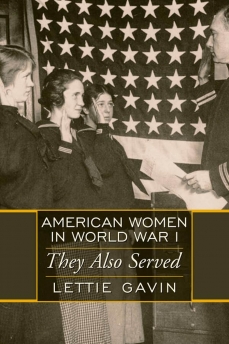Twelve years after the end of the war, former Y.M.C.A. volunteer Francis Grulick wrote this moving account of her days as a canteen worker in France. She had vivid and colorful memories of her days in the forward positions bringing some measure of comfort to the men of the U.S. Army First Division, to whom she was devoted. She was with them at Gondrecourt, Bonnvillers, Boucq, Cantigny and Soissons. She filled their canteens, served them lemonade, poured their coffee, cooked their meals and also saw to it that cigarettes were plentiful. By the time the First Division arrived in Coblenz for occupation duty, she recognized that the unit was composed almost entirely of replacements and that she was the only witness to the First Divisions earliest days in France.
- two from Amazon:

Is your name Anderson?
"Two years ago when the men began to drop out of the industrial world at the call to the colors their women associates gradually slipped into their places, and in the majority of cases effectively filled them... Those men have now nearly all come back to claim their old, or better jobs. What of the girl, then, in the soldier's job? What is she going to do?" This article tells the World War One story of Irene McIntyre, a Salvation Army volunteer who served at the front during the most bloody period of the war: "In her two-hundred and fifty-six days under enemy fire, Irene McIntyre was twice gassed and twice received the unusual distinction of a personal citation in Army orders. She saw more of the war at close quarters than any other American woman. One of her citations read:"
"'Under fire of high explosives and gas, she established and conducted huts that were noted for their good cheer and hospitality. Her courage and devotion to her voluntary work were a splendid inspiration to the troops.'"
1920s Prohibition created a criminal climate
that appealed to more women than you ever might have suspected...
Read about the Women Marines of W.W. II HERE.
This paragraph was lifted from a longer article regarding the battle-savvy Native Americans of World War One and it supports the claims made in 1918 by a number of anonymous allied POW's who reported seeing female soldiers in German machine gun crews toward the close of the war. The article appeared after the Armistice, and this was a time when The Stars and Stripes editors were most likely to abstain from printing patriotic hooey.
If you would like to read another article about women combatants in W.W. II, click here. Here are five quick sketches by the French artist Rabajoi depicting the women of France fulfilling their various obligations as "Mariannes", as sweethearts and as family members.
Always stationed to the most forward field hospitals during America's five major campaigns, a former W.W. I nurse penned this moving reminiscence that recalled her experiences tending to the soldiers who slowly died in the army hospitals. Haunted by the memories of these dying boys, she asked her readers as to whether they feel the world has kept the promises made to those who sacrificed so much: is the France they died to protect a better place? is the country that demanded they fight a better place?
Click here for clip art depicting the nurses of World War One.
|